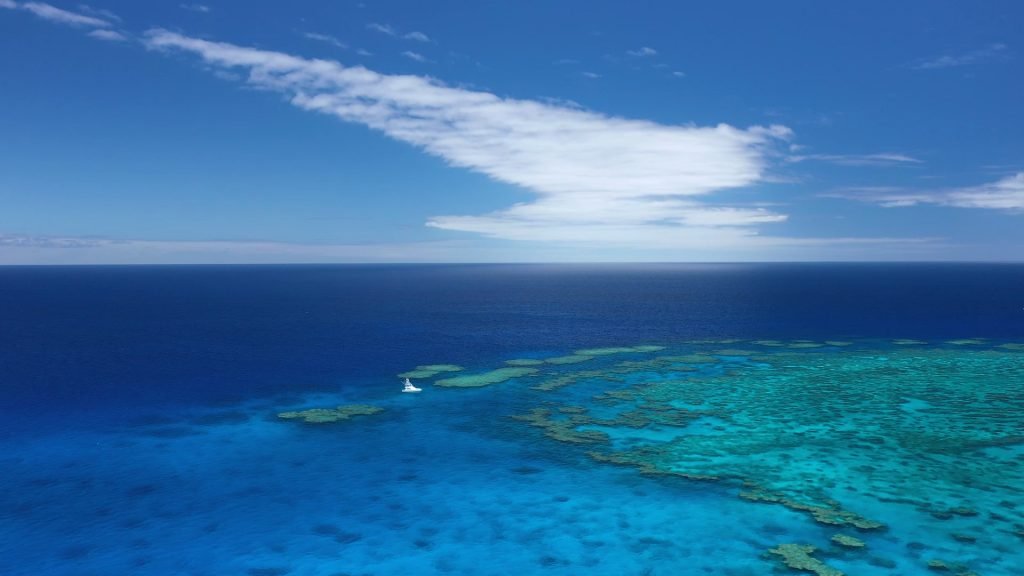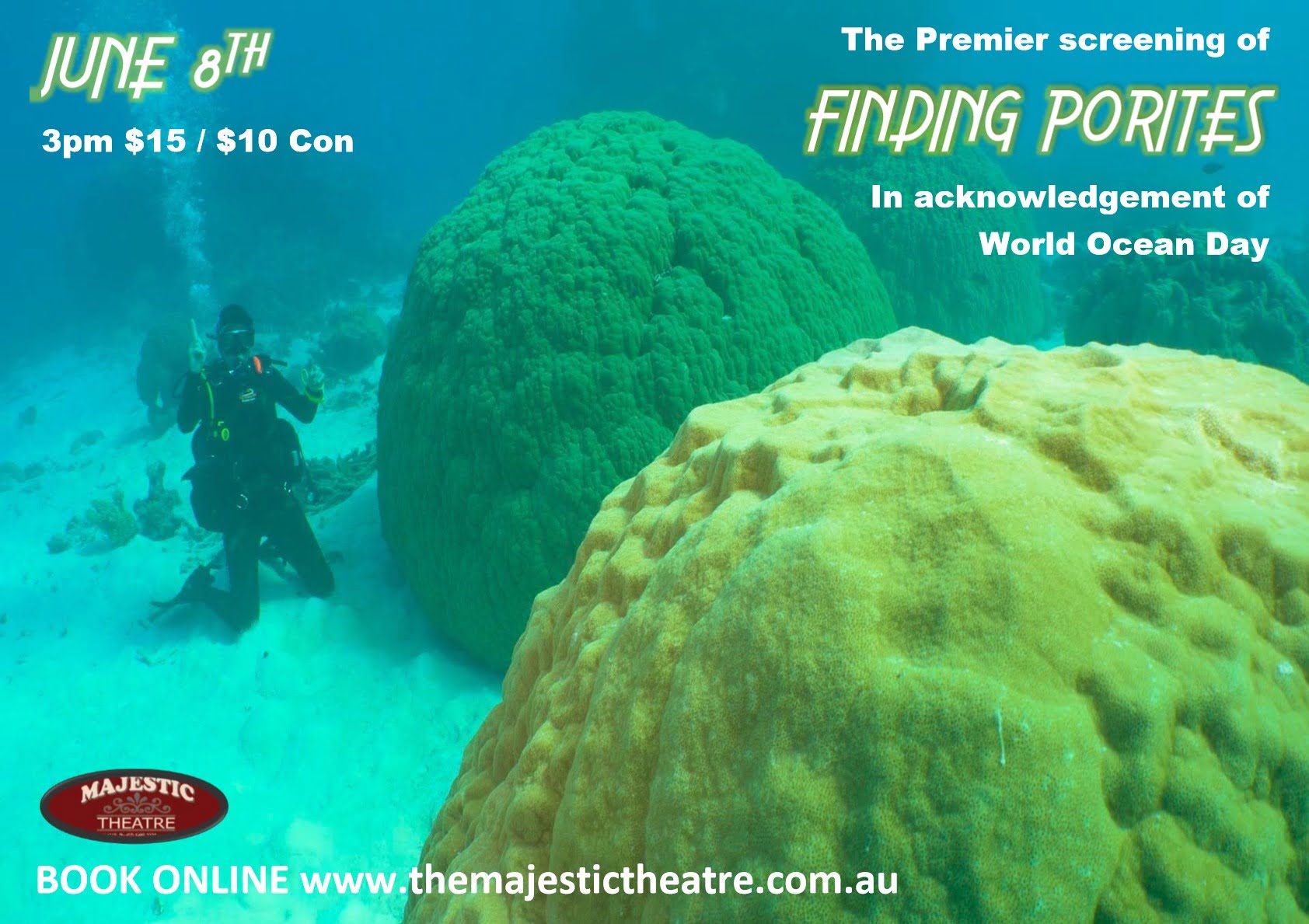Marlin fisherman Rob McCulloch, and I, talked about going searching for the monster corals. I wanted the skipper to take me all the way to Myrmidon Reef, where I knew The Australian Institute of Marine Sciences had once cored these largest Porites. Peter Ridd had told me some of the stories.
Underwater cinematographer Stuart Ireland agreed to come with us, and helped turn this adventure into a film. I had a shot list, that Stuart noted, and then expanded on. He not only filmed non-stop underwater, but took so much drone footage and recorded interviews and also me when I emerged so excited from the dives.
Our short film, Finding Porites, will premiere at the local Majestic Theatre on 8th June. And we now have a short 45-second trailer:
People generally think of corals as delicate and vulnerable, perhaps thin, branching and colourful – easily smashed by large waves during storms, and even worse during cyclones. Then there are the bolder corals that have the scientific name Porites. These monster corals are domed or helmet in shape, and can grow to 10 metres in diameter of dense calcium carbonate so an individual colony weights more than a bus! These are resilient corals that are the foundation of many coral reefs. They have annual growth rings, like tree rings, and so they are time capsules of the ocean’s history.
The Australian Institute of Marine Sciences used to calculate an overall growth rate for the Great Barrier Reef based on coring these corals with the oldest core dating to the year 1572. So, there was more than 400 years of climate history in this coral.
The prediction back in the 1980s was that as global temperatures increased so would coral growth rates. But forty years later we don’t actually know. Because AIMS changed their methodology for coring the massive Porites corals after 1990, and then, after the error was pointed out by recently sacked University Professor Peter Ridd in a study published in Marine Geology (volume 346), AIMS stopped this coring work altogether.
I was repeatedly told the coral coring work had stopped, not because of Peter’s published study but because all the really large and old Porites are now dead from coral bleaching.
It was in October last year, just after Professor Terry Hughes from James Cook University came out with yet another study claiming half the Great Barrier Reef is dead, and just after the skipper (Rob) told me he had no charters/no work because of Queensland border closures due to Covid, that I convinced IPA Executive Director John Roskam to let me go to sea with Rob and two other Marlin fishermen (Wizzy and Denis) to see if we could find the large old Porites – the type of coral that Peter Ridd wished AIMS would core so that we had up-to-date data on coral growth rates.
Marine biologist, and underwater cinematographer Stuart Ireland did agreed to come and film whatever we found. The day before we departed Cairns, Stuart introduced me to Shaun Frichette, a conservationist and deep-sea diver from California who had heard the reef was dead and dying and was keen to come see for himself.
At that lunch I learnt that Shaun didn’t eat fish – he explained that his life mission was to save marine life, not consume it.
Shaun nevertheless was keen to come on the fishing boat, understanding the three Marlin fishermen taking us to sea for a week were as committed as Stuart and me to finding the Porites and knowing the true state of these corals. Shaun just wouldn’t be eating any of the fish we caught along the way! The story of that week at sea together is told in our new film.
The film includes never-before-seen archival footage of AIMS scientists coring one of these monster corals with an hydraulic drill under the sea, and then extracting a core.
I am so excited that this 22-minute documentary will premiere at The Majestic Theatre in Pomona on World Oceans Day – Tuesday, 8th June 2021. I so hope you can make it!
Purchase your tickets at https://www.trybooking.com/events/landing?eid=766421&




 Jennifer Marohasy BSc PhD is a critical thinker with expertise in the scientific method.
Jennifer Marohasy BSc PhD is a critical thinker with expertise in the scientific method.

I haven’t been to Pomona since the early 1980s.
I guess it’s a thriving metropolis now 🙂
Anyway, thanks again Jennifer et al for your dedication and work on behalf of sanity.
Science, history and our children & grandchildren will one day reap the benefits of your efforts in “keeping the b@stards honest”
Hey Mr.
Pomona is still there and part of the Noosa Shire. We have just won a major tourism award, https://www.abc.net.au/news/2021-05-20/queensland-top-tourism-towns-announced-for-2021/100153666. I love this place, and its people. And we are lucky to have mostly escaped the Covid lock downs etc.
If you/anyone else reading this note could help get our film into your local theatre/cinema that would be great?
Also, I would so like to see our little community theatre in Pomona packed-out on 8th June for World Oceans Day. There are just 160 tickets to sell!
I’ll try Jennifer, but where I live now is in a galaxy far, far away. Politically speaking as well as geographically speaking. To question anything Davids Attenborough or Suzuki assert is a hanging offence.
But being a child or the 50s / 60s growing up in SE Qld, I totally get why you love that region. Sun, surf, beaches, sailing, fishing, snorkeling, camping, mud crabbing – what a childhood I had!
To be honest, I’m always a bit deflated now when I see how populated my childhood family holiday spots are now.
But, life goes on (and on, and on, and on . . .)
Just like coral reefs, hey? 🙂
Hy Jen, it looks like you found more than a few Porites coral boulders. How hard did you have to search for them?
I had a less than pleasant encounter with a very large one some years back. I had visited Graham Carson on his cocoa plantation on Ambitle Island east of New Island,, & he asked me if I could give him a lift to his Copra plantation on Nuguria atoll, about 135 kilometers further east.
We arrived at dusk, far too dark to go into the lagoon safely, but Graham knew the passage between the home island & a little one a couple of hundred meters to the north was clear & safe. There was a current running out through the channel, so I let the yacht drift with it while I laid out my chain, then snubbed it off. I expected a gentle stop as the anchor turned over & dug into the bottom, not the violent stop I got when I snubbed off the chain. So violent it broke the chain where it went over the bow roller.
I grabbed my second anchor & got the boat anchored, & found the current was at 3 knots. Next morning there was little current so I grabbed a scuber tank & went looking for my anchor & chain. The bottom of the passage was pretty clear of coral debris & sand, probably swept clear by the current, & right in the middle was a huge Porites coral boulder. Probably about maximum size, it looked like a round double decker bus.
With nothing to sink into the bottom was almost as round as the rest of it. It looked as if it had rolled from higher up than the 25 meters it was in, with bare damaged patches up to a couple of meters diameter, with some other soft & hard corals growing on these.
Swimming around the thing I came face to face with the largest Moray eel I have ever seen, with just his head sticking out of what looked like a burrow. He looked unhappy to see me, so I retreated slowly back around the bolder, cleared my anchor, tied a rope to the back of it & retreated to the surface. Although the water was crystal clear it did not look like the thing had grown there, but it was still alive.
Wish now I had spent more time investigating it, & where it might have grown.
Looking forward to international release and/or web publication. Wish you every success.
Congratulations to your daughter and new son-in-law.
Shaping up to be a fine year for you.
Thanks Jen, once again, for your great efforts in showing the woke of this world that coral culture cancelling is not on.
There are others who strongly support you, too:
https://quadrant.org.au/opinion/doomed-planet/2021/05/simple-clear-evidence-the-great-barrier-reef-is-fine/
So let me understand:
The consensus actually asserted that since the corals are all dead, there is nothing more worth looking for?
And the politicians accepted this at face value and moved to impose the extremist climate policies because of those claims. And thrashed you, fired Peter, and ruined others who simply questioned the consensus.
What is it with extremists and audits?
Blessings to you. I look forward to seeing your video if it becomes more widely available.
Thank you for all you do to show people what real science is all about.
good article, if you need information related to similar articles, you can access it here – http://news.unair.ac.id/en/2019/09/13/water-quality-impact-on-coral-health-prevalence-of-prigi-bay/